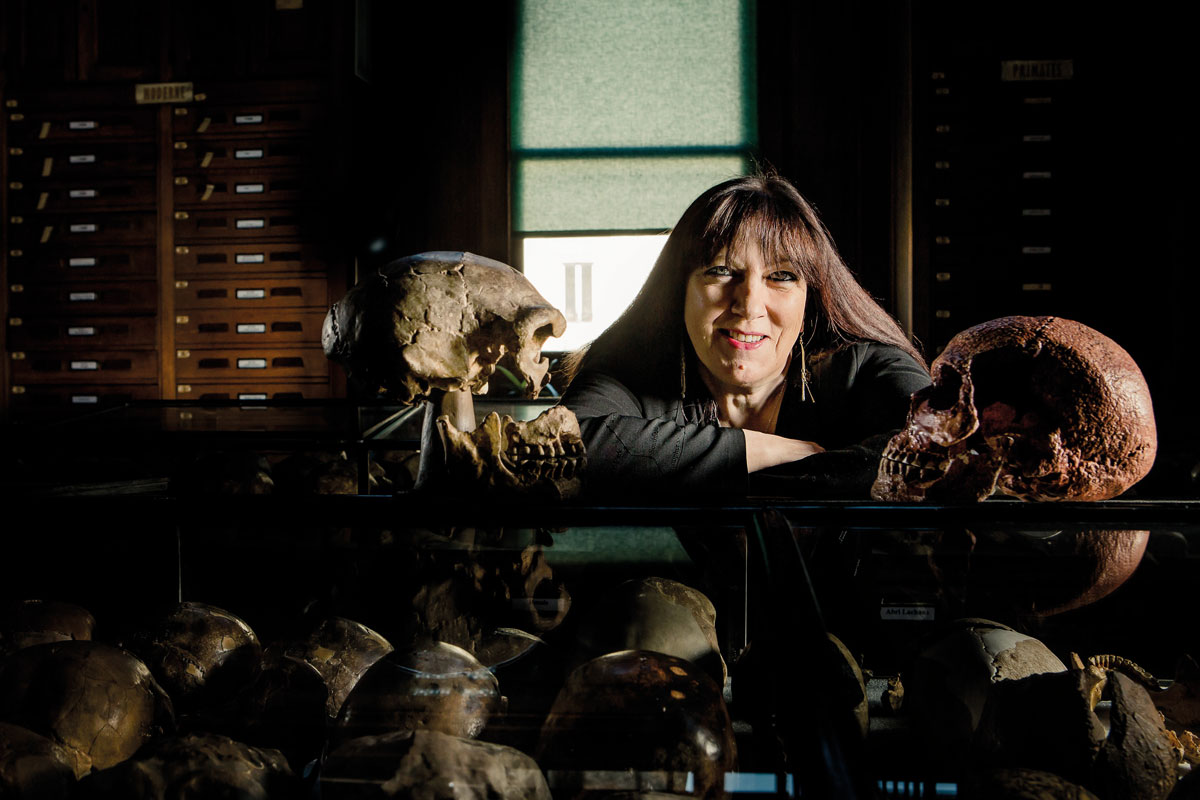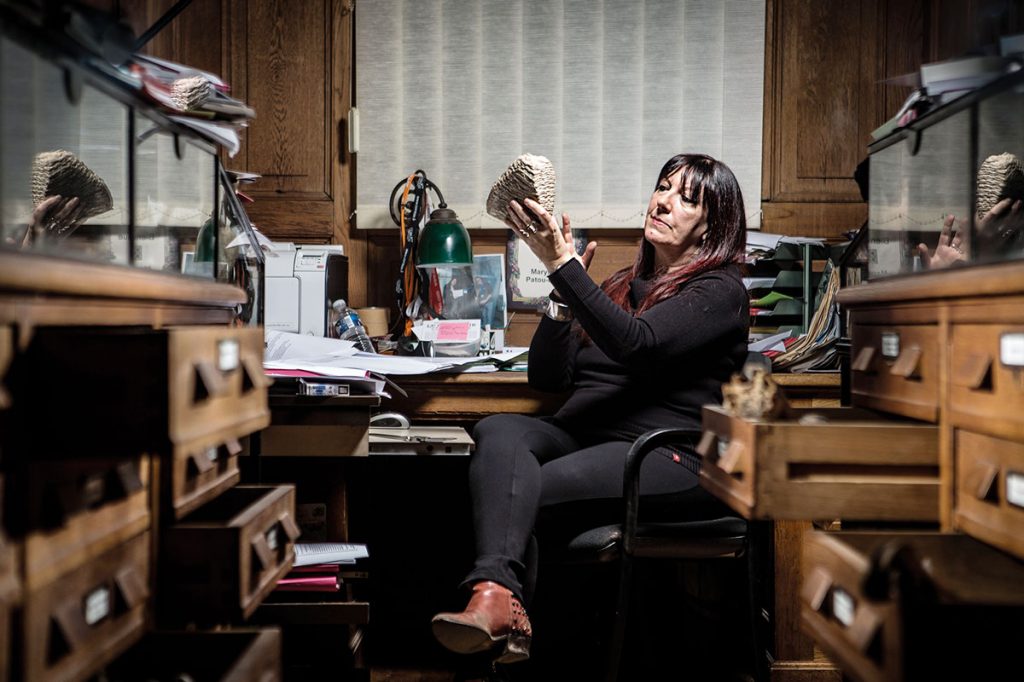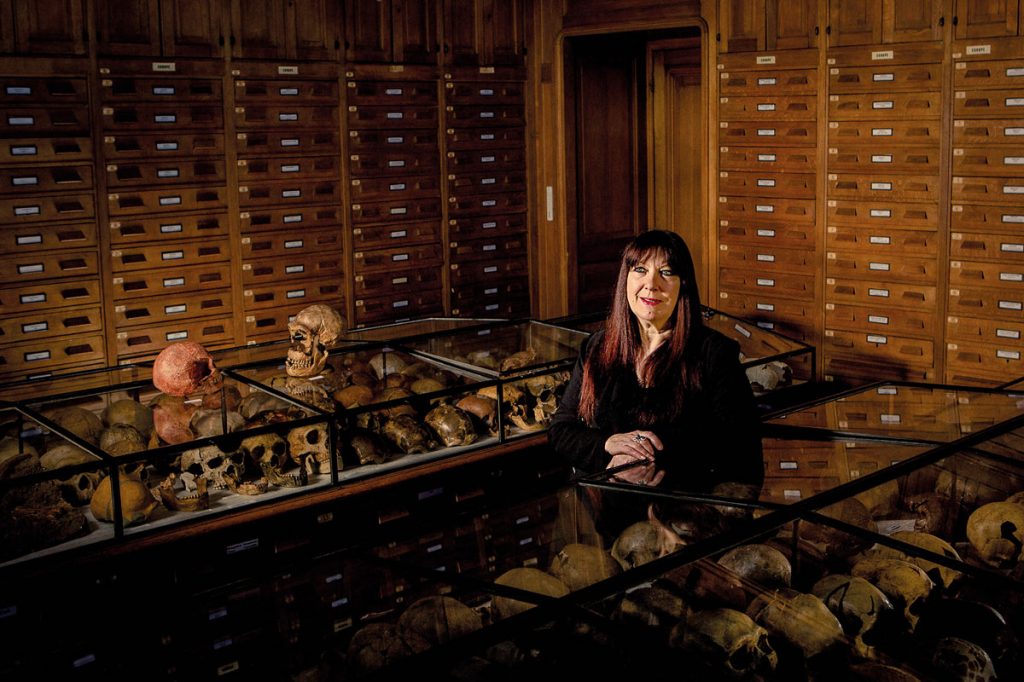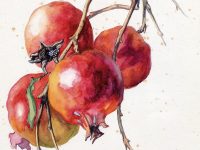Interview with Marylène Patou-Mathis
«We must stop thinking that women were there just to sweep the cave»
Curator at the French National Museum of Natural History

Marylène Patou-Mathis meets us online from her Paris office, surrounded by folders, documents, and filing cabinets. Professor Patou-Mathis (Paris, 1955) works as a prehistory curator at the French National Museum of Natural History, and as research director at the CNRS, the French National Centre for Scientific Research. She is one of the great specialists in Neanderthal behaviour, and her work, both in research and in dissemination, has contributed to changing the our mental image of this hominid species, which we consider to be increasingly closer to us. In her latest book, L’homme préhistorique est aussi une femme (“prehistoric men were also women”, 2020), the prehistorian wanted to delve right into the clichés and stereotypes about prehistoric women. These prejudices have been mainly popularised by cinema and other popular culture products, but are based on a discipline – prehistory – which, according to the author, stopped basing its claims on this subject on scientific evidence a long time ago. Were hunters always men? Did no female hands create cave paintings? Did the patriarchy already exist during prehistoric times? We talked to Marylène Patou-Mathis on these and other issues the researcher deals with in depth in her book.
You are a specialist in Neanderthals and, as you have explained on several occasions, you were very concerned about the expression «Neanderthal men», as well as other variants, such as «prehistoric men» or «cavemen». In this sense, do you think that women have been invisible to prehistorians?
Of course they have. But most importantly, this is not just a matter of vocabulary; essentially, frequently only prehistoric men are discussed, and women are often relegated to the background. And this is what is important to me, because ultimately, this is a matter of visibility.
You dedicate the first chapters of your book L’homme préhistorique est aussi une femme to analyzing the origins of prehistory as a discipline. Is it important to know the context in which this discipline is born in order to understand the role that women have played in the narrative of prehistory?
It is essential. Because for a long time, the assumption that prehistoric women performed certain activities or had a certain social status was not entirely based on archaeological data. So we have to check where this idea comes from. Prehistory is a relatively young discipline, which really started to gain strength in the 19th century. And, in addition, prehistory is mainly made from Western Europe. So necessarily the first prehistorians came from very patriarchal societies and when they tried to reconstruct the way of life of prehistoric humans, what they did was copy their own society. And at this time [in the 19th century], women were subordinate to men: they were very dependent, had no weight in economics or politics… Therefore, in this context, it is not surprising that prehistoric men were seen as the great hunters, the inventors of fire, the ones carving tools and painting on the cave walls. And women were supposed to do nothing but take care of the children and gather food. This perspective must be put into context, because it was later disseminated through art, novels, in different representations, and would become deeply rooted in the popular imagination. The first female prehistorians did not appear until approximately 1950. It is important to keep this in mind, because for a long time only men studied prehistory.

In this context, women were considered inferior, as were non-white people and other human species. You have studied Neanderthals extensively. Does the vision of this species as inferior also have its roots in this historical context?
Physical anthropology was developed in the 19th century, and then everything started to be measured, and all humans on the planet were hierarchised and classified in a somewhat dramatic way: from the lowest to the most superior. And the same occurred with the fossil record: Neanderthals, Cro-Magnons, Sapiens… One thing I realised when studying these issues is that, in each and every one of these categories, women always appeared as inferior to men. For example, the Hottentots were considered to be an inferior people, and women were even lower on that scale. In addition, during this time, there was a unilinear vision of evolution, that is, it was considered that we had undergone a continuous upwards evolution and we were now «better» than we were before. This vision was very strong and meant that all previous humans, Neanderthals, and Upper Paleolithic cultures, were forcibly considered inferior. But we currently know that this is false. From a biological point of view, we know that there were several coexisting human species: Neanderthals, Denisovans, and Sapiens. And the same was true from a cultural perspective.
Regarding this incorrect understanding of progress, you also criticise the idea that today’s hunter-gatherer groups are a reflection of prehistoric communities. Is it wrong, for example, to draw conclusions from the role of women in these societies and transfer it to prehistoric societies?
Yes, I do not think the behaviour of today’s hunter-gatherer communities can be used as a model of prehistoric societies. For two reasons. First, from a scientific point of view, we know that groups evolve and all societies change and are modified when they come in contact with each other. We cannot expect people to remain unchanged for 10,000 years, it is just not possible. Perhaps we can observe how they work and carve materials, and that may help us understand some techniques, but to believe that we can take their thinking, cosmogony, and society as a model of other groups of the past makes no sense. All communities have a history. And the second point why I cannot accept this is because we actually cannot talk about a single prehistoric society, but about different societies. And that goes for today’s Europe or Africa, too. Talking about «our society» is merely a Western illusion. And this was already the case in prehistory, as we see in the materials they used, the different techniques for carving tools, the great diversity of representations… There were different traditions. And all this leads us to wonder whether there would be a sexual division of labour, with male hunters and female gatherers. Well, maybe, or maybe not. Maybe in certain societies it was one way and in others, it was the opposite. We must avoid having a single view, we must take a step back and have some perspective.
Improving genetic techniques or new protein analysis techniques have allowed us, for example, to discover that skeletons that were thought to belong to male hunters – because of the weapons and accessories that had been found in their graves – were actually female hunters. Are scientific advances key to this new perspective?
This sort of thing makes me very angry. Because it seems like we need to prove that women hunted. Prove that only men hunted, then! But that is just not done, it is simply accepted. When you find a tool such as a hand axe, we can deduce many things: its approximate age, whether it was used with the right or left hand, etc., but we cannot say who carved or used it. There is no way to know, there is no proof. And yet it was accepted for decades that it was a male activity. But as women, we are required to prove that women did it. What we should look for is scientific evidence that such sexual division of labour actually existed. And seeing what I have seen about the great diversity of Neanderthal societies, I am sure that this will depend on each period and region. And what the analyses of proteins and DNA tell us is that in the Paleolithic, and also in the Neolithic, there were extremely robust women. So when a tomb with weapons was found, the remnants were evidently thought to be male, even though the skeleton did not allow us to know whether it was a man or a woman. Or if we found a tomb with very important funerary offerings, it was automatically identified as an important man, perhaps a chieftain. And thanks to new techniques, we can now show that this was not the case: sometimes women were buried with weapons, and they sometimes had extensive funerary offerings. Anyway, there is nothing to indicate that sexual division was the norm in the Paleolithic period, nor that women were considered inferior. Nothing. In terms of diet, we do observe a change in the Neolithic period (women ate less protein than men), but this was not the case in the Paleolithic. And when it comes to cave art and furniture in Europe, it was female. If in certain societies there were female divinities, this means that femininity was very important. Children were the future of the clan and ensured the survival of the group. And if children were important, then so was their mother. Babies come out of the mother, the father was… [laughs while making a dismissive gesture]

But we did the opposite, we attributed hunting or art – activities that according to our current point of view have more prestige – to men, and we considered women’s tasks, such as caring for children or gathering food, less important.
What we need to do is precisely to get rid of this trap, stop thinking that hunting was somehow more important than gathering. For a long time, many villages have hunted, but most survived thanks to gathering. The animal part of the diet was random, a supplement, but the economy was based on fruit collection. So to say that one activity is more important than another is a big mistake. But taking care of the children was also very important. In all the art we have found there are many female representations, because fertility was very important. It was almost sacred.
Are these ideas increasingly accepted within the academic world or do they still find some opposition?
It is still quite difficult. Some colleagues will still tell you that the sexual division of labour has always existed. And to them I say: Why do you think that it was men who painted the cave walls? In the Lascaux or Chauvet caves, how do we know those were men? In many caves, we have found female hands on the walls, why couldn’t they have painted the horses that were just next to the handprints? Why would it not be women who controlled the fire? Why do we attribute flint toolmaking to men? We currently have great women prehistorians who carve this material very well. So it is still difficult. And you also meet women who have not yet accepted this vision of things and are obsessed with emphasising that women have always been oppressed. They are fighting to prove that this oppression has existed for a long time. But they do not realise that if we show that in some societies this was not natural and the patriarchy did not exist, that would be great. Because if it is not natural or genetic, then it is cultural and we can change it. This is good news.
There is a relatively recent case in Spain that raised a small controversy over the way in which a young Homo antecessor was represented. In 2021, dental tissue analysis revealed that the body we know as “the boy of Gran Dolina”, in Atapuerca, was actually a girl. So the illustration representing this individual was redrawn and the result was a girl, with longer hair, a sweeter expression, and more modern beauty… Do we tend to think about women of the past based on our own current parameters?
Of course. I do not know if you remember the illustration of a woman hunter from Peru. They drew her in a pink dress! [laughs]
Do researchers need to make an effort to get rid of prejudice when facing the study of prehistory?
I think it is important when interpreting findings. This is where we need to be very vigilant. This was the conclusion I reached, because when I started, I did not ask myself any question in this regard for many years. It didn’t even occur to me. A few years ago I included some illustrations for a book I wrote, titled Lascaux: Histoire d’une découverte, and I included men painting. I would not do this now, but I had interiorised it so much that I didn’t even think about it. That is why it is essential to ask ourselves some questions: do I have proof that what I am saying is true? If it is not proven, the solution is not complicated at all: we can simply say that they may be men or women, or a combination, and that is all. But we must stop having «men» as the default option. This could change everything. We would begin to see that certain innovations, certain hunting techniques, certain tools might be a female invention. Women, like men, have contributed to human evolution. We must stop thinking that we were there just to sweep the cave.





